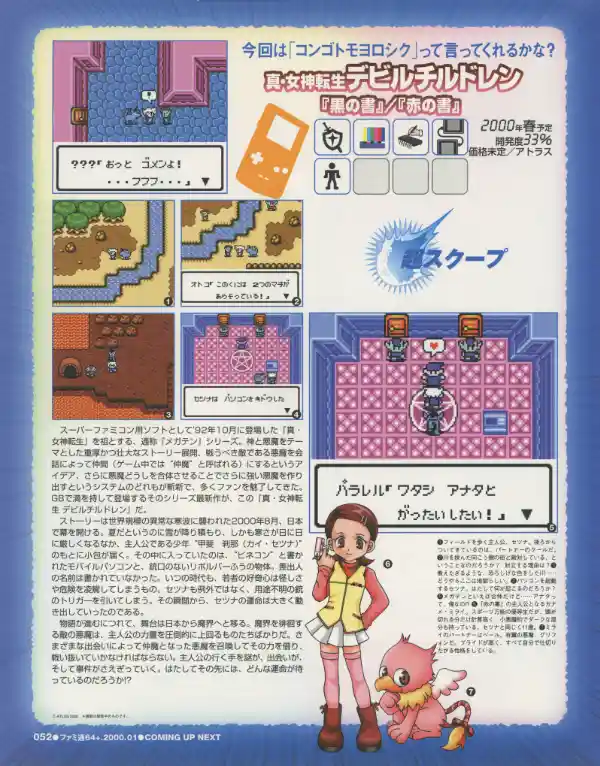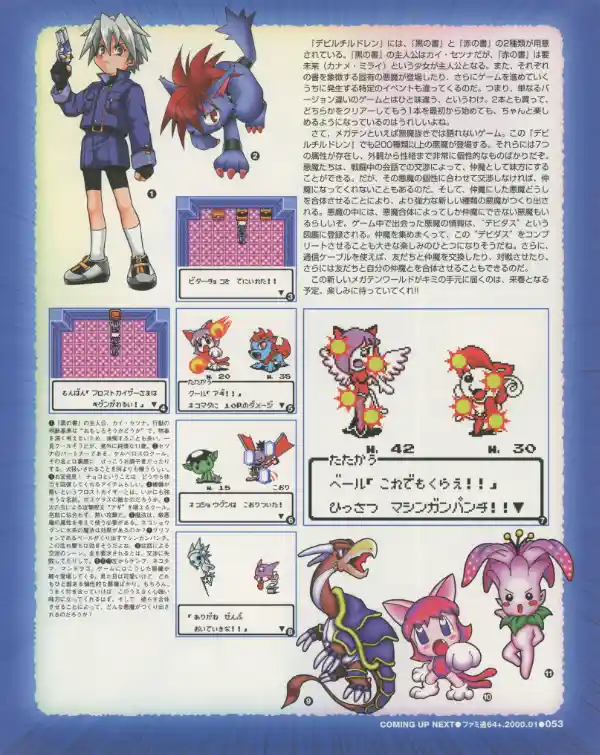Devil Children Unsolved Mysteries
 Source: Hideaki Fujii
Source: Hideaki Fujii
Last updated: 2025-12-06
Author: Interipelli
Devil Children was a big, sprawling project during the period it was especially active in its first two years. With that come a number of unexplained mysteries through early media, potential misprints, and content that came out many years since the project's golden era.
- Makai-den Collectable Stickers
- Devil Children White Book Sept 2020 version
- Early Famitsu 64+ preview differences
- Why were Devil Children Red Book & Black Book delayed?
- GREE Chil Devil Art
- Takajou's Gender
Let's do our best to explain some of the more notable ones.
Makai-den Collectable Stickers
Among the promotional items released as part of the Devil Children media mix campaign was a line of stickers including early in-game lore for each of the demons, characters, items and spells.
Interestingly some of the demons featured showcase names that weren't the final ones used for the manga, game or anime. Particularly, Orochi is known as "Tsuchigumo", and Hel is known as "Kaiser Frost".
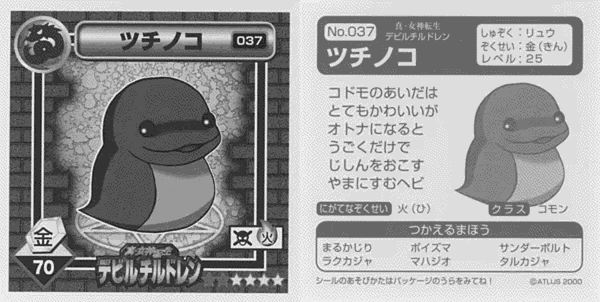
Why were these early names changed? Tsuchigumo being retooled as "Orochi" could make sense for the purposes of Red Book's ranked fusion, as Orochi will eventually rank up to the beast Yama-no-Orochi.
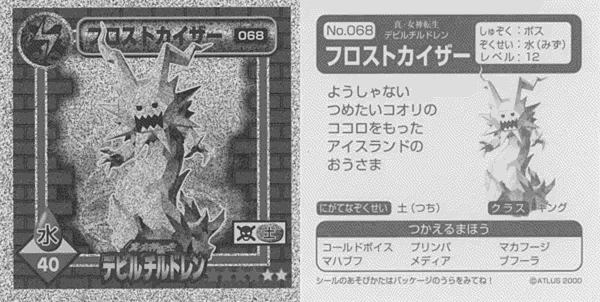
Kaiser Frost is especially puzzling, as the fearsome tyrant of Ice Land lords over a society of Jack Frosts with an iron fist in the game. Were there objections to the name, or was it decided that a mythological reference was more appropriate for the character than "evil King/Queen Jack Frost"?
There is also a unique design for Sphinx among these stickers that looks nothing at all like Nagahisa's smug looking, red headed partner demon.
Setsuna has an unusual profile that frames him as an inquisitive child who wants to look smart. A bit different from a goofy punk that he's usually cast as, to varying degrees of "goofy" and "punk" depending on the work in question.
Devil Children White Book Sept 2020 version
A recently discovered version of Devil Children White Book has been recovered from a source, around September of 2020. At this time, it's most notable for having the upside down pentagram of Masaki's Devil Raiser coloured white, instead of the same orange colour scheme as Setsuna's Devil Raiser. This is not a retail version of the game.
It's unclear if this is a cancelled 3DS Virtual Console version or a planned second revision that was never released. The ROM header indicates that this is version 1.1 of a Japanese region version of the game, with no other distinguishing marks.
There is a possibility that some demons alleged to be in White Book that fans have yet to find, such as the Nebiros-inspired "Black Count" (クロダンシャク) mentioned in the Famitsu strategy guide, might be in this version. To this day, nobody has done enough spelunking through the ROM to see what differences lie in the game besides the refreshed title screen.
A quick comparison of the ROMs does indicate that there are fewer differences between this version of White Book and retail than there were for the 3DS VC re-release of Black and Red Book and their retail Game Boy Color cartridge counterparts.
Perhaps this was a bugfix or a smaller update that might have been overlooked, given Black Book and Red Book on the Game Boy Color continued to sell fairly well through their first and second years thanks to the popularity of the manga and anime.
Come to think of it, isn't it odd that Atlus' White Book came out six months after the original two games, ignoring the original planner concept, and hardly any Devil Children media acknowledged it? There was a light smattering of print works; two of the five trading card game expansions, one 4koma collection, and a one-off Comic Bombom special issue. Meanwhile, Black Book and Red Book continued to have a presence for two whole years between the manga running to completion, the PlayStation port with high profile voice acting, and the anime being renewed for a second season. Many White Book original creations like Iron Kitsune, Jashin and Raguel were curiously written out of continuity.
Early Famitsu 64+ preview differences
The Famitsu 64+ January 2000 special as shared by Sotono is notable for having very early versions of Bastet, Cait Sith, Nekomata and Quicksilver along with early digital art of these demons. Many of these designs did not appear in the final game, and appear to have been done by another artist entirely.
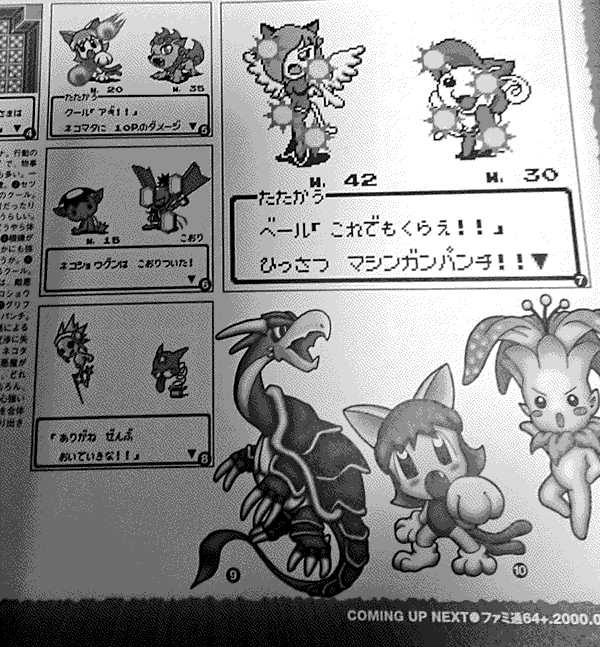 Source: Sotono Michi
Source: Sotono Michi
Bastet, in particular, is radically different from the version found in the game, who looks more like a tabby cat with huge breasts than this preview's biped in a bodycon dress. Who could have done these, if not Maeda, and why were these iterations rejected?
Additional images reveal that the game was intended to take place in August 2000 instead of July, and the healing items were going to be based on foods like chocolate instead of the traditional Megaten items.
Other differences look like small editorial changes, such as how the Vinecon laptop computer was originally referred to as a "ビネコン" (leading with a "bi-" sound) instead of a "ヴィネコン" (with a "vui-" sound). Likely to make it a bit clearer that the "Vine" in branding was referring to Solomon's demon.
Note that in the screenshots the minions refer to their boss as "Kaiser Frost", the same name used to refer to Hel in the Makai-den Collectable Stickers.
Full page scans are reproduced below; click on them for higher resolution versions.
Some of these screenshots appeared in an early Comic Bombom preview booklet describing the first pair of Devil Children games. The timing is unclear as to which came first, and exactly with what issue of Comic Bombom that preview booklet was released. Though vintage issues of Comic Bombom appear from time to time, the companion booklet has yet to turn up on auction sites.
Why were Devil Children Red Book & Black Book delayed?
Devil Children Red Book and Black Book were said to have had an initial release date of Spring of 2000 in the January 2000 Famitsu 64+ preview. That would have been closer to when the game canonically begins, in July 2000.
However, the games were delayed to November of that year. Still within the estimated release date of "2000" that Atlus gave on the first official Devil Children website, but certainly on the later side.
Given most of MIT/Atlus's games tend to share resources and MIT's GB games at times reuse game logic to the degree of resembling asset swaps, why did Red Book and Black Book take longer than Guru Guru Galactors relative to Last Bible?
Could that be one reason why White Book appeared so soon after the prior two games, and with a substantially revised concept from what Yogiri had in mind?
Noteworthy Edits to the Manga in Reprints
Sometimes manga and anime receive touch ups and adjustments between the initial release and compilations. The Devil Children manga was no exception.
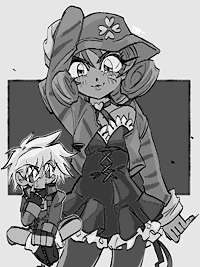 Source: shiransouco [1]
Source: shiransouco [1]
Some of the more interesting changes of note include:
- Only three types of demons ambush Setsuna and Mirai in Ice Land. This scene is completely redone with a greater variety in reprints.
- The appearance of an original character in court with Hel, replaced by Fenrir in the reprints. DANDAN speculates that this character looks like Cool's father.
- An entire scene with Elegy confessing her love for Setsuna in front of Asmodeus and Cool as she gruesomely annihilates two armies is exclusive to the reprints. This never appeared in the pages of Comic Bombom. The original sequence cut from Elegy taking a swing at Fenrir to a giant explosion surrounded by murderous energy snakes.
These particular changes are identical between the original "KC" Kodansha collections from 2001 to 2002 and the 2013 Re:BOMBOM editions sold today on Amazon.co.jp.
GREE Chil Devil Art
A fair number of the "new" designs in GREE's short lived Devil Children mobile game from the early 2010s are obviously digitally touched up versions of the original devils, either with new clothes painted on or with new colour schemes.
One clear exception is in the three "Baal Brothers", which have baby versions that the player is intended to rank up into the Baal Brothers as we know them. What's fascinating about these is that they look like Maeda art as she used to colour her works.
Was this (relatively) new Maeda art created specifically for the GREE game, or are these designs that were left behind as Atlus/MIT/Yogiri's planning company were still figuring out the concept behind Red Book's "ranked fusion"?
Takajou's Gender
It's certainly not rare for pretty boys to become the subjects of crossdressing. Takajou goes a little further than most.
In the depths of the Japanese internet are rumblings of a secret Mixi page with private journals from Hideaki Fujii himself addressing fans. Some might say that is the source of a Takajou with plural gender, or perhaps with more feminine features.
While I cannot confirm the presence of such a Takajou on Mixi, there is a much more readily available source in print. The fifth volume of the original printing of Uma Wars: Kukuru and Nagi exchanged the usual creator's commentary and "omake" comics hosted by cartoon Hideaki Fujii with advertisements of his prior printed works.
The one for Devil Children has an interesting tweak.
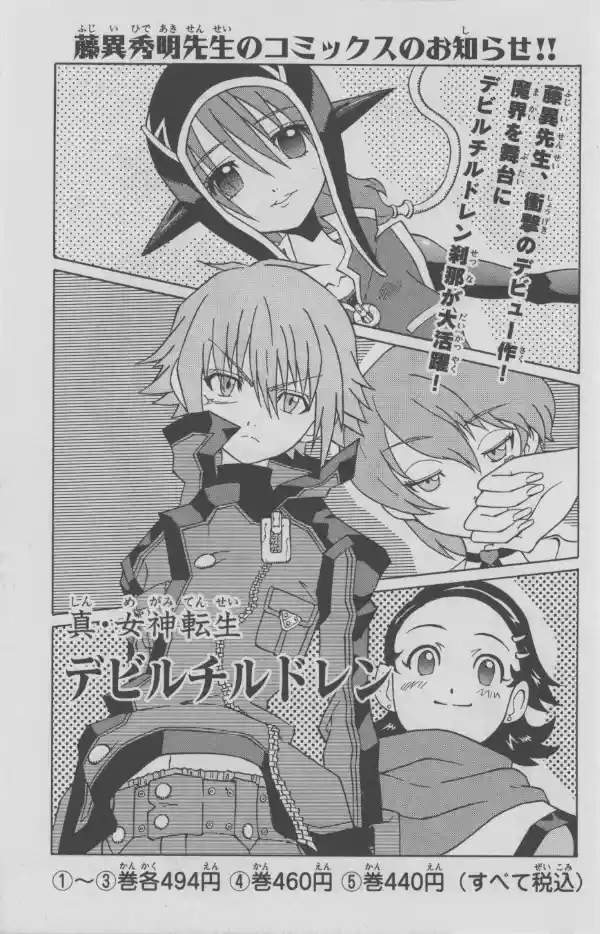
Standing upright with a visage normally reserved for cute girls in need of stronger, older folks — or Set-chan — is Takajou. Donning a more pronounced bustline than usual.
We're all adults, here. Come to your own conclusions.
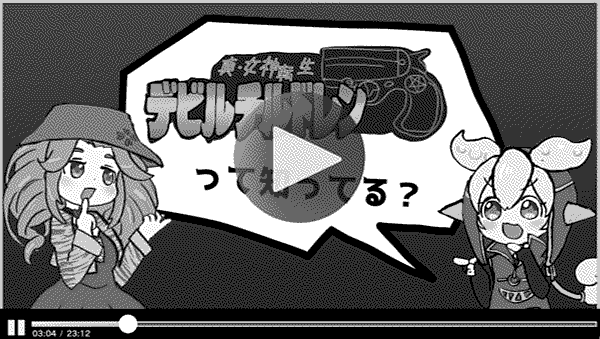 Source:
Source: 